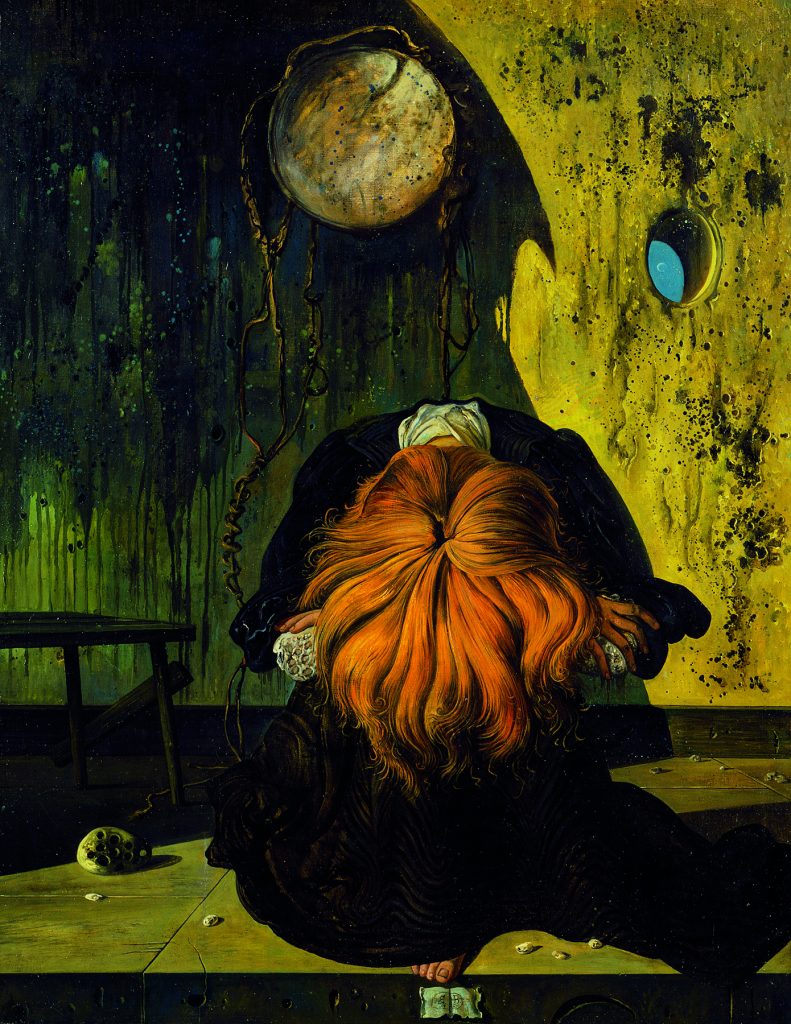Sunset (Medusa) (work of art)
Información sobre la obra de arte
Key Ideas
- This work is from a series of oil paintings the artist made in the early 1940s, during World War II. Each painting in the series features a woman (whose face cannot be seen) and elements of crumbling and decaying architecture.
- This is an example of neo-romantic art. Neo-romanticism is an art movement that began in the 1800s. Neo-romantic art often depicts landscapes in a dramatic way that expresses difficult emotions and feelings of anxiety and despair. The landscapes of neo-romantic paintings often have a mournful quality.
- The title of this work and the subject’s wavy hair are references to the Greek myth of Medusa. Medusa was a woman who had live snakes growing out of her head instead of hair. Anyone who looked her in the eyes was instantly turned to stone.
- The woman depicted in this painting is Ona Munson. She was an American actress who later married Eugène Berman.
- Berman was a Russian-born American artist known for his imaginary landscapes and theatrical stage set designs. Many of his paintings focus on feelings of loneliness and human isolation in times of war.
Más información
In Sunset (Medusa) a female figure, dressed in black velvet and lace, kneels on a shallow stage in front of a decaying wall. Her face is hidden from view. The woman depicted in this painting was modeled by Ona Munson. She was a stage and film actress who later became the artist’s wife. This work is Eugène Berman’s interpretation of the snake-haired Medusa of Greek mythology. Medusa had the ability to turn anyone who looked into her eyes to stone.
In the early 1940s, Berman created this work as part of a series of paintings of individual women. Each painting features a woman standing or sitting, with her back to the viewer or crouching with her face hidden. The background of each painting depicts signs of decay. Berman once explained that the “curious, spattered, almost mouldy surface” of his paintings symbolize “all the bullet-holes with which the world’s walls have been peppered during [World War II], as well as our whole moral and spiritual degeneration.”
Berman was an American artist who was born in Russia. In 1918 he and his brother fled the Russian Revolution and settled in Paris, France. In Paris they both worked as neo-romantic painters and designed sets for plays and operas. Neo-romantic painters focused on creating personal, poetic imagery of landscapes and the human body. The landscapes of neo-romantic paintings often portray dreamlike scenes with drooping, sad-looking human figures. Many of Berman’s paintings depict lonely landscapes with broken and decaying architecture.
Almost everything today requires re-examination, re-discovery of values and new experimentation . . . Never before did we have so much material to confront us, to confuse us, and to drive us to despair.
Eugène Berman
Berman moved to New York City in the mid 1930s and became an American citizen. Throughout the 1940s he lived and worked in Los Angeles. He became well known in America as a set and costume designer for ballet and opera productions.
tags: conflict, meaning, reflection, mythology
Recursos adicionales
Recursos para los profesores
- Read an article about Eugène Berman.
- Explore a virtual gallery of paintings by Berman.
- Read an article about neo-romanticism.
Recursos para los estudiantes
- Read the artist’s biography.
- View another painting from Berman’s series that includes Sunset (Medusa).
- Read a short article about the myth of Medusa from Britannica Kids.
Imágenes
-

Sunset (Medusa)
An oil painting of a crouching woman with her head down on her folded arms. Her long red hair hangs loosely over her, hiding her face. She is wearing a long black dress trimmed with white lace around the neck and wrists. In the background there is a decaying yellow wall. It is divided by areas of light and shadow.
